March 28, 2016
By Pamela Berns
Imagine waking totally refreshed from a good night’s sleep to a morning light that invigorates you enough to skip your daily caffeine jolt, walking the kids to a school where the air and light quality actually enhance their learning and health, and then heading to a workplace that inspires creativity and collaboration, and helps keeps you fit while you work at your desk. Picture your family living, learning, working in, and traveling to indoor spaces that encourage good nutrition and regular hydration with pure, clean water. Sound impossible?
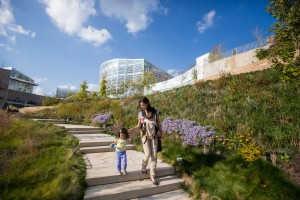
Phipps Center for Sustainable Landscapes
As the
WELL Building Standard™ (WELL) continues to spread around the world, and the impacts of well building practices on human health continue to be validated, this lifestyle is becoming reality. And given that human beings spend 90 percent of their time indoors, it’s a most welcome advancement.
What is WELL?
The WELL Building Standard is grounded in a body of medical research that explores the effects of spaces on the people who occupy them. Pioneered by the wellness and real estate technology firm
Delos™, it’s the culmination of seven years of rigorous multi-disciplinary R&D and peer review, and is administered by the
International WELL Building Institute™ (IWBI™). The WELL Building Standard is a performance-based system that measures, certifies, and monitors features of the built environment that impact human health and well-being. While WELL is the first building standard to focus exclusively on this connection, it’s also designed to complement and work seamlessly with the
US Green Building Council’s LEED certification system, as well as other leading green building systems. In fact, IWBI has joined forces with Green Business Certification Inc. (GBCI), the same organization that administers LEED certification, to provide third-party certification for WELL.
Depth and Breadth
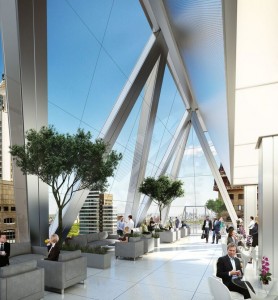
425 Park (Photo Credit L&L Holding Company)
WELL identifies approximately 100 performance metrics, design strategies, and policies that building owners, designers, engineers, contractors, users, and operators can implement. These multiple parameters fall into seven categories or “Concepts”: Air, Water, Nourishment, Light, Fitness, Comfort, and Mind. In addition, the WELL Building Standard highlights how features impact major human body systems, which include the cardiovascular, digestive, endocrine, immune, integumentary, muscular, nervous, reproductive, respiratory, skeletal, and urinary systems.
Here are just a couple of examples of how WELL may help to maintain healthy system function: The endocrine system is made up of glands that secrete hormones to regulate such processes as growth, immunity, metabolism, reproduction, mood, and digestion. Through the Nourishment and Water Concepts, WELL Certified(™) spaces can help mitigate or eliminate exposure to potentially harmful disruptors, such as ingested compounds that mimic hormones. The respiratory system works in tandem with the circulatory system to provide oxygen and remove carbon dioxide from body tissues. Through its Air and Fitness Concepts, WELL can support this system by helping to improve indoor air quality, limit exposure to airborne molds and microbes, and foster access to opportunities for greater fitness.
And the WELL Building Standard goes beyond the physical aspects of health; it also helps promote healthy behaviors. For example, the Water Concept not only evaluates the chemical safety of drinking water, it also examines whether the locations of water sources encourage occupants to hydrate.
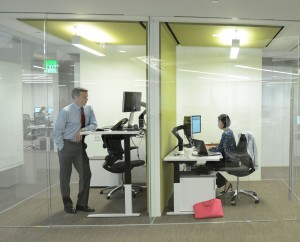
Ergonomics at CBRE
Fitness may be addressed by both the inclusion of furniture such as “sit stand desks” and the construction of staircases that entice walking rather than elevator riding. The Lighting Concept considers both task lighting features and Circadian lighting, which syncs our bodies with the progression of natural daylight. Thus, occupants not only increase the potential to be more productive on individual tasks, they can also be selective about the most productive times of day to do them. The Nourishment Concept helps cafeterias go beyond availability of healthy food to providing for appetizing displays of these items and plate sizes that encourage healthy portions. The right placement of nutritious morsels can even reduce cravings for unhealthy snacks. WELL even considers the impact of social equity and altruism on our sense of well-being. In fact, IWBI, which is itself a public benefit corporation, has committed to direct 51 per cent of the net profits (after taxes) generated by registration, certification and recertification fees toward charitable contributions and impact investments that focus on health and wellness and the built environment.
A Growing Body of Knowledge
The WELL Building Standard grew out of research that looked at many types of buildings and human demographics. For example, according to the IWBI online “Course: Introduction to the WELL Building Standard” (go to
https://www.wellcertified.com/learn for free access), the
EPA reported that substandard environmental conditions in schools could cause serious health problems, including asthma, for children; on the other hand, the Canada Institute of Education Sciences pointed to “
numerous studies that indicated that students exposed to proper lighting showed better attendance… and better academic performance than students exposed to poor lighting.”
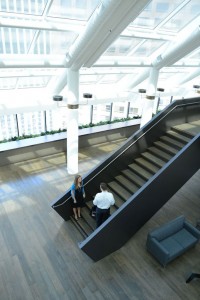
Staircase at CBRE
Turning to adults and the workplace, CBRE Group, Inc., the world’s largest commercial real estate company, was also the world’s first WELL Certified™ office building through the WELL Building Standard pilot program. The focus in their Los Angeles Corporate Headquarters was on indoor air quality, lighting, water quality, visual acuity, physical comfort, acoustics, and psychological impacts within the work environment. In a post-occupancy survey, the building’s occupants overwhelmingly reported a positive effect on health and well-being, better business performance, greater collaboration, and an increased capacity to generate business. As a result,
CBRE has committed to pursuing WELL Certification for at least 100 buildings, sites, or offices managed by or associated with CBRE worldwide. Additionally, CBRE plans to professionally accredit 50 CBRE employees through the
WELL Accredited Professional (WELL AP) program.
To further illuminate the impact of the built environment on human health and wellness, Delos and the
Mayo Clinic have collaborated on the
Well Living Lab. Located in Rochester, Minnesota, the Lab features a sensor-rich research space that can be configured to simulate a variety of environments. Such flexibility can deepen understanding of the impact of indoor environments on residents, students, employees, customers, and just about anyone else who spends time in indoor spaces. CBRE is also a founding alliance member of the Lab.
Getting More Well All the Time
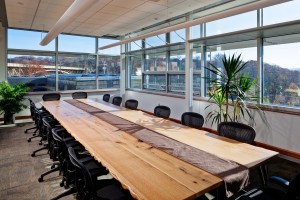
Phipps Center for Sustainable Landscapes
While the current WELL Building Standard v1 is optimized for commercial and institutional buildings, pilot programs are now also available in retail, multifamily residential, education, restaurant, and commercial kitchen projects. And WELL is now an internationally recognized benchmark certification for human health and well-being in offices.With the benefits of WELL, even as developing nations continue to tackle potential solutions to their severe outdoor pollution problems, they can positively affect their citizens’ health by turning their attention to healthy indoor spaces. In fact, as a first step in a strategic partnership between Delos and the Chinese real estate company
Sino-Ocean Land, the
first mixed-use complex in China has registered to pursue WELL Certification in Guangzhou. Plus, with the increasing adoption of WELL building practices, new metrics and data will certainly emerge.
As interest in WELL continues to grow around the world, it has the capacity to touch all of our encounters with the built environment and, in turn, help us to more productively inhabit the planet.
Want to Learn More about WELL?
IWBI offers a number of
resources for the building and design industries, as well as individuals interested in becoming WELL Accredited Professionals (WELL APs), many of which informed this article. For a good introduction, visit the
Learn link and register for a free introductory course, and take a look at the
FAQ link. If you want a deeper cut, you can register and download a number of PDFs with varying amount of detail about the WELL Building Standard, such as WELL Summary, the WELL Brochure, the WELL Building Standard v1, the WELL Certification Guidebook, and the WELL Performance Verification Guidebook, all of which served as sources for this article.
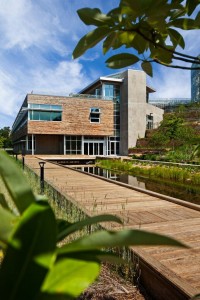
Phipps Center for Sustainable Landscapes